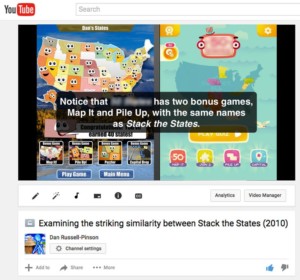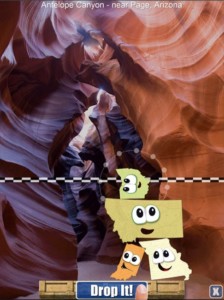ACT | The App Association member Dan Russell-Pinson recounts his experience dealing with, and defeating, a copycat app. This Member Blog shares his words of wisdom for app developers and content creators who may find themselves in a similar position.
By Dan Russell-Pinson
Imagine yourself casually browsing the iTunes App Store to check out the latest releases. An app catches your eye, and you tap on it to learn more. But when the details load, you can barely believe your eyes — this “new” app is actually a copy of your own.
This is exactly what happened to me earlier this year. While perusing iTunes, I noticed an app featured in the “Notable Education Apps” section that looked eerily familiar. Upon further investigation, I discovered that the app was a functional, illegal copy of my successful geography app, Stack the States. I was shocked. How could someone take my app, my labor of love, energy, and years’ worth of time and money, and present it as their own? What could I do to protect the integrity and credibility of my product and ensure the copycat was removed?
|
Screenshot from my app, Stack the States (2010) |
Screenshot from the copycat app (2017) |
Thankfully, my story has a happy ending. After months of research, correspondence, and legal arguments I had the copycat app removed from the App Store. The process wasn’t fun, and required substantial time, patience, and determination. However, it is possible to defeat a copycat, and I wanted to share my advice for any app developer or content creator who may find themselves in the same predicament.
Understanding the Content Dispute Process
After recovering from the shock of discovering a copycat of my app, I spent a lot of time researching my options. I determined that Apple’s Content Dispute process was my best course of action to address the copycat company and have the app removed. Apple provides a platform to submit a claim to the App Store Legal Team if you find yourself in a situation where an app or an ad violates your intellectual property rights. Here’s what you need to know about Apple’s Content Dispute process:
- If you believe your app has been pirated, be honest, clear, and thorough when describing your complaint. You should:
- Clearly enumerate and describe each infraction using bullet points.
- Highlight whether the infringing party has broken a law, and describe each legal infraction with relevant details. If you have registered a trademark and/or copyright for your app, provide that information.
- Identify whether the copycat app has violated any of Apple’s policies, and be sure to include them as well.
- Stick to the facts. Do not exaggerate any details to try to help your case, or attack the infringing party. Though it may be tough, it is important that you leave your emotions out of your complaint.
- This is a dispute process, therefore everything you write in your complaint will be shared with Apple AND the infringing party. This is yet another reason to follow the advice above to ensure you are not caught off guard.
- Manage your expectations. Apple’s Content Dispute process is designed to connect the conflicting parties to work out the issue themselves. Apple does not play an active role in the initial process.
Taking the Legal Route
After the Content Dispute process was initiated, it took the infringing party, a European game company, a full month to respond to my complaint. When they did reply, their response was heavy with legal jargon, clearly intended to intimidate and encourage me to back down. Amidst their legalese, the company implied that because I didn’t register a copyright for Stack the States, I couldn’t fully assert my rights to protect my original creation. This was simply not true. They also tried to argue that Stack the States lacked originality and creativity, suggesting that my app consisted of commonly accepted, public domain ideas that any geography app would inevitably include. I knew, and anyone who has played Stack the States could attest, that their argument didn’t hold water.
This initial interaction was challenging. I am an app developer, not a lawyer, and I was out of my comfort zone dealing with these legal matters. While I was grateful to receive guidance from different lawyers to formulate a response to the copycat’s legal arguments, I still didn’t feel comfortable relying so heavily on other people to argue my case. As I continued to trade legal correspondence with the copycats I knew that as long as the dispute was rooted in legal rules, and not the evidence of the infringement of my app’s intellectual property, no real progress was going to be made.
Trying a Different Approach
After a few months of correspondence, I created a six-minute video that outlined, in painful detail, how the copycat company had systematically copied Stack the States. I sent the video, which featured several side-by-side comparisons of the copycat app using the same content and doing the exact same functions as Stack the States, to the copycat company and to Apple. The video was so compelling and difficult to deny that it completely changed the conversation.

Screenshot from the six-minute video showing the striking similarities between Stack the States and the copycat app.
Within eight days, the copycat company agreed to update their app. They agreed to remove most of the content, leaving only generic features to which I couldn’t claim rights, like the function of placing states on a map. Though it seemed like we finally reached a solution, the copycat response was only lip service — they didn’t follow through with their promise, and I found all of the same features they copied from my app when I downloaded their app again. Back to square one.
I reached out to the copycat company yet again to inform them that their update was not sufficient, but they ignored me and insisted to Apple that they did everything necessary to resolve our dispute. Their response prompted me to make yet another video to outline how the “updated” copycat app continued to infringe Stack the States’ content. I sent my video to Apple and the copycat, but they still didn’t offer to fix their app.
Each day I was more frustrated. The copycat was not upholding their end of the agreement, and I was approaching the five-month mark of trying to remove a copycat app that was gaining attention and popularity for my content. I had no option but to write a strongly worded complaint to Apple to explain the situation and the uncooperative nature of the copycat company. A few weeks later, I received an email from Apple notifying me that they removed the copycat app from the iTunes App Store. I don’t know what was the straw that broke the camel’s back, but I was relieved that my persistence paid off.
So, What Did I Learn, and What Should You Take Away?
1) Evidence is key. If your app has been copied as egregiously as mine, take the time to create an unassailable case, via video, letter, or PowerPoint that proves it beyond a doubt. Strong evidence has the power to shift the burden of proof to the infringing party. Before I presented the video evidence, the copycat denied any wrongdoing and refused to take any action to remedy the dispute. After the video evidence, their first response was an offer to remove all copied content from their app.
2) Always maintain the high ground when dealing with the infringing party. This wasn’t always easy, especially considering the immature behavior and constant delays from the copycat. As my experience shows, Apple can eventually intervene to make a judgment. When they do, you want them to see you as a rational businessperson presenting legitimate, compelling evidence, not a frustrated person hurling insults.
3) Always ask for what you want. It is vital that you make your complaint, and your requests, clear. If you want the offending party to change the name of their app, request that specifically. If you want Apple to remove the offending app from the App Store, then explicitly ask for that at the end of every email correspondence to them.
4) Use the leverage that you have. Oftentimes, copycats just want to benefit from other people’s work, with little work of their own. The offending party might be concerned that Apple could rule against them, or they might view the dispute as a nuisance. In either case, they want the dispute to go away. You have the power to end the dispute (e.g., agreeing to a compromise) or to extend the dispute. As the legitimate business, you should leverage this power to your advantage.
5) Persistence pays. As app developers and innovators, our intellectual property is the backbone of our business. If protecting your creation is as important to you as it was to me, don’t quit. But remember, the dispute process can be mentally draining and time consuming. Be sure to lean on the support of people and friends around you and take time for self-care until the case is resolved.
I hope never have to defend your app against a copycat. Your work is yours and should be respected and protected. But if you do, I hope you may use my story and my advice to find a successful outcome. Keep fighting!


